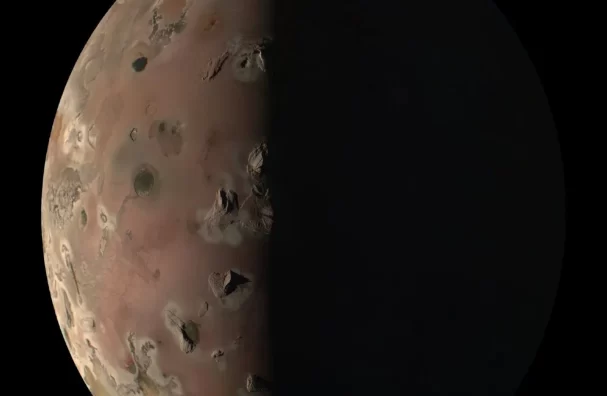
Since its launch in 2011, NASA’s Juno spacecraft has been on a monumental voyage, uncovering the hidden secrets of the largest planet in our solar system, Jupiter. Not only has Juno enabled us to get a closer glimpse of Jupiter, but it has also shed light on the giant planet’s intriguing satellites, particularly its volcanic moon, Io. The spacecraft’s latest triumph involves a close encounter with Io, revealing fascinating images of its volcanic activity.
Although the images that have been making rounds on the internet are artist’s renditions based on Juno’s data, they offer an unprecedented view of Io’s volcanic landscape. The data was gathered during Juno’s low-altitude flybys of Io in late 2023 and early 2024. The probe flew at a distance of approximately 930 miles (1,500 kilometers) from Io’s surface.
One of the most striking features revealed by Juno’s flyby is a lava lake named Loki Patera. Spanning about 127 miles (200 kilometers) in diameter, Loki Patera is the largest volcanic depression on Io. The lake is dotted with multiple islands and exhibits a smooth, glass-like surface, indicative of cooling lava.
The primary source of this data is JunoCam, Juno’s onboard imager. However, Juno’s Microwave Radiometer (MWR) played an essential role in the process. The MWR is equipped with antennas distributed around the spacecraft, operating between 600MHz and 22GHz. This operation range allows the MWR to penetrate Jupiter’s dense atmosphere and provide crucial data about Io’s surface, such as the presence of smooth volcanic lakes.
Io holds the title of being the most geologically active moon in the solar system, boasting hundreds of active volcanoes. So, the presence of lava flows on its surface was not surprising. However, the smoothness and reflectiveness of certain regions left the researchers astounded.
“The specular reflection our instruments recorded of the lake suggests parts of Io’s surface are as smooth as glass, reminiscent of volcanically created obsidian glass on Earth,” said JPL’s Scott Bolton.
Research has revealed that Io is noticeably more reflective than other moons orbiting Jupiter. This suggests that the constant lava flows could be continually reshaping its surface.
While Juno has completed its primary mission to study Jupiter, it continues to orbit the gas giant. To protect itself from the planet’s intense radiation bands, Juno follows long elliptical orbits. These orbits allow Juno to occasionally fly by moons like Io and lower its altitude over Jupiter’s north pole, enabling the MWR to penetrate deeper into the planet’s cloud layers. This strategy has yielded substantial data on Jupiter’s polar cyclones, and scientists anticipate gathering more until the mission concludes next year after completing 76 orbits.
